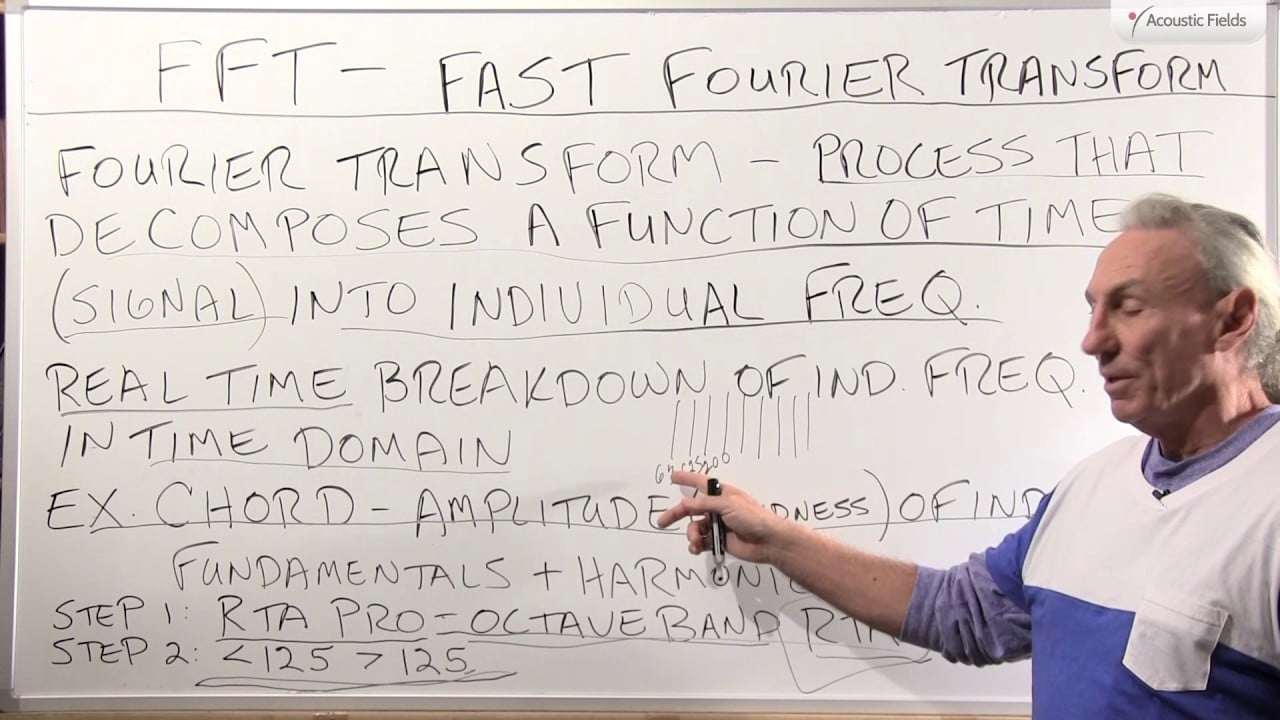Today we’re going to talk about the Fast Fourier Transform; crazy name isn’t it? It means a lot, probably named after an individual. We call it FFT for short, but it’s a really great tool when you’re trying to learn about acoustics, and are trying to apply results and analysis. So let’s look at the definition – the process that decomposes a function, a signal into individual frequencies. We are all familiar with RTA’s, so it’s a real-time breakdown of individual frequencies in the time domain only.
That’s what we’re looking at here the time domain; so real-time. So if we take a chord, the chord’s going to have certain amplitude or loudness and we break that down that chord into its individual fundamentals and harmonics. I can go into long lengthy explanation here, but I’m going to give you an app, an iPhone app, and it’s called RTA Pro; and I think maybe Brian can put a picture of the symbol up for you in this video. So it’s called the RTA Pro, I think it’s like two or three dollars, it’s not very expensive, buy it, download it into your phone and start becoming familiar with it. It’s not complicated but there is a little bit of a learning curve to it.
So start with the real-time analyzer, the RTA in there, I think it is 1/3 and 1/6 octave if memory serves me correctly. So use it in your room, use it when you talk, use it when you go to restaurants and then you familiar with how it works, familiar with how it is measuring in real-time; they look at two different frequency groupings to get familiar with it. That energy below 125 cycles, and energy above 125 cycles, and that’s a good breakpoint in acoustics to look at. So get familiar with how energy moves. You are going to see the energy below 125 really do this. You’re going to see the energy from 125 do this and this. So you’re going to see a lot of patterns and variations.
Then when you become familiar with the octave bands switch over to the FFT function, and what you’re going to see is you’re going to see individual frequencies within all those octave bands. So you’re going to see 63 cycles, you’re going to see 125 cycles, you’re going to see 200. You’re going to see each octave band of the RTA broken down into individual frequencies and you are going to see those frequencies and their relative strengths as they compare to their brother’s and sister’s frequencies. The RTA gives you a feel for how energy moves in your room and the Fast Fourier function, the FFT function gives you specific frequencies within it. I guess you could say it’s like looking into a crowd. You see a group of people that would be RTA, they are moving and doing this and then you pull individual people out, individual frequencies out and label them you can see that. And you can see their strengths in relationship to the whole movement, and it’s those frequencies that we treat when we are coming to acoustic treatment.
FFT – Fast Fourier Transform, hope that helps a little bit with an explanation.
—
This is an unedited transcript from our video series from Acoustic Fields. There will be some errors in grammar and sentence structure that occur during this translation process.
For complete understanding and comprehension, please view the video which is included in this text. For any additional information regarding this topic or others relating to room acoustics, please contact us directly at:
P: 520 – 392 – 9486








Hey Dennis
a) sorry you don’t have a real email address.
b) very odd we’ve never met…
c) I just linked to you on the Boston Audio Society links page – you’re in good company.
B, You can reach me at info@acousticfields.com